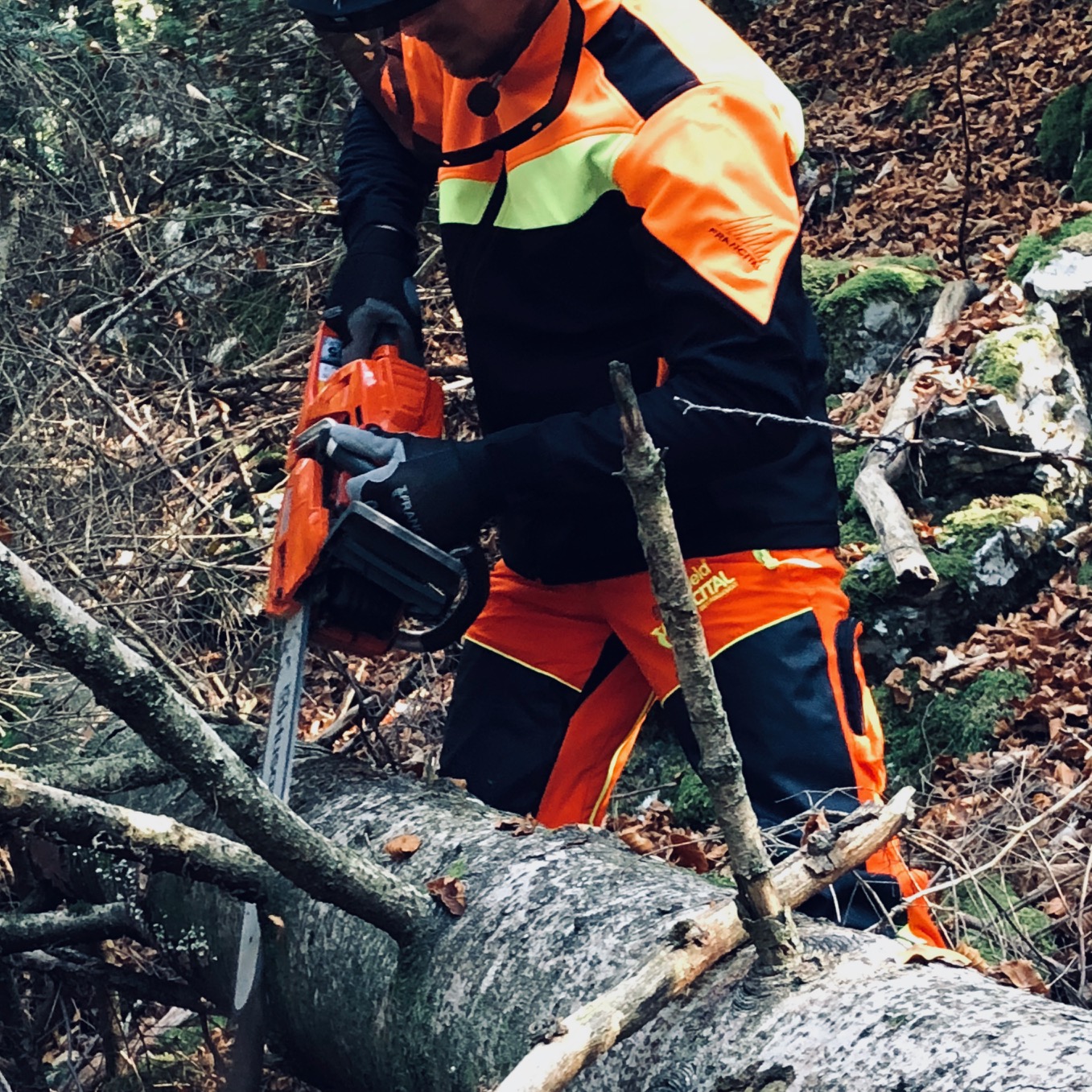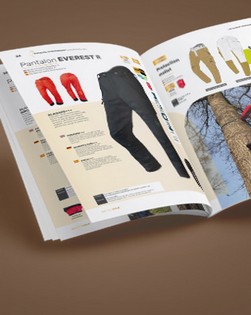When we open the PSA file, we should take the European sources (the 1989 Directive repealed by EU Regulation 425/2016, a source of beautiful and rich discussions), the Labour Code and the texts applicable to each sector of activity.
It is without pretension that we have decided to improve this subject by addressing the points for which we are often questioned. We hope to provide you with a good clarification. This reading can be completed by our article "PSA & FOREST SITE" and our presentation of the STANDARDS.
Let's start with a definition. What is a PSA?
The French Labour Code provides us with an answer.
Personal protective equipment (PSA) is a device or method intended to be worn or held by a person in order to protect him against one or more risks likely to threaten his safety or health mainly at work (Labour Code, Article R. 233-83-3).
In the context of prevention, what is the place of a PSA?
In a work situation where workers are exposed to risks, the employer must first identify and assess these risks.
This risk assessment will enable it to define the preventive measures that can be put in place to protect the health and safety of its employees. The main objective of these collective measures will be to eliminate or reduce risks.
Collective protection must be the priority.
Where risks cannot be avoided or effectively limited by technical means of collective protection or by measures, methods or procedures of work organisation, PSA must be worn.
Which PSA to choose?
The workstation should be analysed, taking into consideration the importance of the risk, the frequency of exposure, the performance of the PSA.
PSA must be appropriate to the risks to be prevented, adapted to the worker and compatible with the work to be performed.
However, in certain work situations, texts require the employer to use specific PSA.
In France, this is the case on a forest site:
Decree No. 2016-1678 of 5 December 2016 on health and safety rules on forest and forestry sites, which entered into force, determines, in particular, the personal protective equipment to be worn by operators and amends Article R717-83 of the Rural Code:
"All interveners who work on an active forest or silvicultural site are equiPSAd with:
- a head protection helmet;
- safety shoes or boots, adapted to the terrain;
- a brightly coloured garment or accessory that allows other operators to see them.
However, in the case of silvicultural work and where the nature of the work in question justifies it, workers may be exempted from wearing a helmet. ».
In addition, to ensure the effectiveness of rescue services, company managers working on forest sites must take "the necessary measures to ensure that the people present on the site are able to communicate with each other by any appropriate means or combination of means". The communicating noise cancelling solution can be considered.
It is also specified that in addition to these PSA, workers who use a chainsaw are equiPSAd with:
"a protective screen or glasses against splashing;
- noise protectors;
- the gloves;
- trousers or similar clothing to prevent the risk of cuts specific to the type of chainsaw used.
Shoes and boots must also be chosen in such a way as to prevent the risk of cuts specific to the type of equipment used. »
Rural and Maritime Fisheries Code - Article R717-83-1
Illustration of mandatory PSA on a forest site: Click here!
How to choose a PSA?
It is necessary to take into account the constraints of the work situation and compatibility with ergonomic principles (ease, weight, thermal comfort, etc.). The wearer must be at the heart of the choice and it is interesting to plan a trial period.
For some PSA, the adjustment to the user's morphology determines the effectiveness of the protection.
It is imperative to avoid that PSA constitutes an unjustified source of discomfort for the user or may generate another risk.
Performance of PSA
Reference should be made to the PSA marking and instructions for use to know the performance of a PSA. This is an obligation imposed on the manufacturer. You can also consult their EU certificate of conformity.
Before being placed on the European market, PSA is evaluated on the basis of standards setting out test methods and performance requirements.
The standards and the tests they impose are a reference for evaluating equipment and defining a level of performance.
These are the tests that the experts considered to be the most representative. However, it should be noted that standards testing cannot reflect actual conditions of use or all work situations.
Two important points should therefore be kept in mind:
1/ It is important not to confuse the performance level of a PSA with the level of protection at the workplace.
2/ It should not be forgotten that PSA does not guarantee absolute protection in all circumstances.
The obligations of employees and employers with regard to PSA
Obligations of the company manager:
Inform the operator, train him and provide him with appropriate personal protective equipment: R 4321-4, R 4323-1 and R 4323-91 to R 4323-106.
In the forestry sector, it is therefore necessary to:
- Choose a machine suitable for the work to be done or suitably adapted for this purpose R 4321-1 and R 4321-2.
- Ensure the conformity of the machine and its maintenance in conformity with R 4322-1 and R 4322-2.
- Read the instructions and understand the operation of the R 4323-1 machine.
The employer must provide PSA free of charge, check that it is not damaged and maintain it periodically, replace it when necessary and ensure its compliance. He must ensure that PSA is properly used. Training may be required (Article R4323-95 of the Labour Code).
Employees must follow the instructions given to them by their employer. Employees must ensure that the use of PSA is in accordance with its intended purpose and is for professional use only.
Ranking PSA
PSA is classified into three categories:
Work equipment covering minor risks (class I) Specific protective equipment for major risks (class II)
Safety equipment (class III) for serious risks with irreversible or fatal effects.
Category I PSA is subject to self-certification (the manufacturer undertakes that the PSA will comply with the claimed standard), Category II PSA is subject to an EU Type Examination Certificate procedure (a notified body ascertains and certifies that the PSA complies and issues an AET, an EU Type Examination Certificate, valid for 5 years). Category III PSA is subject to the EU Type Examination Certificate procedure and, in addition, the manufacturer subjects its production system to quality assurance supervision (approval and supervision of the quality assurance system set up by a notified body).
What is the impact of the entry into force of Regulation (EU) 2016/425 of 9 March 2016 for "anti-forestry cutting" PSA?
Forestry equipment changes category. These products protect against risks that can have very serious consequences such as death or irreversible damage to health, so they become category III PSA.
What are the consequences?
The conformity of equipment protecting against the risk of chainsaw cuts must be examined as part of an assessment procedure carried out by a notified body which then issues an AET, an EU Type Examination Certificate, valid for 5 years and a production control procedure must be put in place.
Since FRANCITAL Environnement has been certified as a category III PSA since 2017, the quality assurance procedure for its production method by a notified body, LRQA, n°0088, has already been put in place.
Performances of PSA
Reference should be made to the PSA marking and instructions for use to know the performance of a PSA. This is an obligation imposed on the manufacturer. You can also consult their EU certificate of conformity. The standards and the tests they impose are a reference for evaluating equipment and defining a level of performance. These are the tests that the experts considered to be the most representative. However, it should be noted that standards testing cannot reflect actual conditions of use or all work situations.
Before being placed on the European market, PSA is evaluated on the basis of standards setting out test methods and performance requirements.
CHECKING AND MAINTENANCE OF THE PSA
Personal protective equipment (PSA) is likely to be damaged, degraded, soiled, etc. They also wear out depending on the duration of wear and environmental conditions.
However, the employer, as part of its obligation to achieve results in terms of health and safety at work, is required to maintain work equipment, PSA and installations in good working order. They must therefore be regularly maintained and checked.
As a reminder, PSA is provided, free of charge, by the employer. The latter must set the conditions for the provision, use, maintenance and storage of these PSA, inform the personnel concerned (written instructions) and ensure their use (Article R4323-95 of the Labour Code).
Who can carry out the checks?
Verifications are carried out by qualified persons, whether or not they belong to the company.
Recording of results:
The results of these verifications, tests, examinations and controls shall be recorded in a safety register.
Pre-use check
Before each use, PSA must be checked to ensure that it remains in compliance with the technical design rules applicable to it. It is therefore necessary to check the indicators of deterioration of PSA (expiry date or period, wear and tear of components, etc.).
This preliminary check is the responsibility of the employer and the user: the employer must inform the employee, train him or her and ensure that the checks are carried out.
Periodic verification of all PSA
The employer's periodic verification allows him to check the state of compliance of PSA and to define whether there is a need for renewal or repair of the PSA (Article R.4323-95 of the Labour Code). This verification is carried out on PSA in service and in stock.
It is the employer's responsibility to define a frequency of the audit and to ensure that it is done by a competent person within or outside the company.
The frequency of verification must be adapted to the constraints to which PSA is subjected during its use.
For some PSA, the regulations under article R4323-99 of the Labour Code require the employer to determine the nature and frequency of the verification.
General periodic verification for some PSA
Article R4323-99
Decrees of the ministers responsible for labour or agriculture shall determine the personal protective equipment and categories of personal protective equipment for which the employer shall carry out or have carried out periodic general inspections in order to detect in good time any defect likely to cause dangerous situations or any lack of accessibility contrary to the conditions of availability or use determined in accordance with Article R. 4323-97.
These decrees shall specify the frequency of checks and, where necessary, their nature and content.
This general periodic verification of PSA makes it possible to detect in good time any defect likely to cause dangerous situations.
A decree of 19 March 1993, amended on 22/10/1999, establishes "the list of personal protective equipment that must be subject to the periodic general inspections provided for in Article R. 233-42-2 of the Labour Code".
- self-contained breathing apparatus for evacuation;
- respiratory protection devices and complete equipment for accidental interventions in hostile environments;
- inflatable life jackets;
- personal protection systems against falls from a height;
- stocks of anti-gas filter cartridges for respiratory protection devices.
For work involving risks of exposure to asbestos, a decree of 7 March 1993 requires that respiratory protection devices be checked after any intervention on the equipment or any event likely to reduce its effectiveness or at least every twelve months.
Periodic general inspections are carried out by a qualified person, with the necessary skills for this mission and knowledge of PSA regulations, whether or not they belong to the company. The list of authorised persons shall be made available to the labour inspectorate.
The results of these verifications, tests, examinations and controls shall be recorded in a safety register.
Where the periodic checks are carried out by persons not belonging to the establishment, the reports drawn up following these checks shall be annexed to the security register.
Nature of the audits
Audits should focus on:
- the general condition and, inter alia, the state of conservation;
- the functioning;
- the resistance;
- the compatibility of the equipment between them;
- safety elements - comfort elements;
- compliance with the prescription dates, depending on the instructions. They concern in particular: the source of oxygen and the tightness of autonomous respiratory protective devices intended for evacuation;
- the oxygen source, tightness and effectiveness of protection of respiratory protective devices and complete equipment intended for interventions in hostile environments;
- the source of gas and watertightness of inflatable lifejackets and the operation of the striker; the general condition of the envelopes of the energy absorbers, seams, fixing methods and the proper functioning of the mechanical parts of the personal protection systems against falls from a height.
In summary....
In addition to the PSA mentioned in the 1993 decree, the other PSA, whose use is qualified as permanent, with the exception of disposable equipment, must be regularly checked for its effectiveness and maintained in a state of compliance.
This verification is carried out on PSA in service and in stock.
The check is carried out before each use on the basis of the instructions given by the manufacturer in the operating instructions.
For PSA mentioned under Article R4399 and the Order of 19 March 1993 amended on 22/10/1999, an annual verification must be carried out.
The verification of PSA, equipment and installation should be recorded in the Security Register.
Users must comply with and apply the instructions for use, storage and maintenance of the equipment as indicated in the instruction manual delivered with each piece of equipment.
It is also everyone's responsibility to report any defective and/or outdated equipment.
.jpg)
 FR
FR EN
EN DE
DE ES
ES
